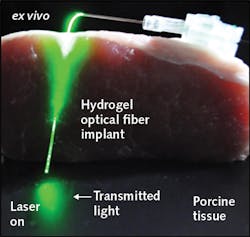Hydrogel fibers could be used as mechanical and biochemical sensors
Hydrogel materials have already been identified for use as smart bandages and as biocompatible tissue scaffolds. Now, researchers at the Massachusetts Institute of Technology (MIT) and Harvard Medical School (both in Cambridge, MA) have succeeded in developing hydrogel optical fibers that are not only flexible and stretchable, but have light-guiding properties that enable their use in biological sensing applications.
Composed of a hydrogel core and a polymer cladding, the hydrogel optical fibers at first suffered from separation of these two materials upon bending or stretching. To combat this issue, the researchers created a molecular-level glue by adding conjugation chemicals that linked carboxyl groups in the cladding and amine groups in the core. By injecting colored dyes into the fiber and measuring the output at various wavelengths as the fibers are stretched, an effective mechanical strain sensor is possible that could be implanted within a patient to monitor physical movement during therapy and inflammation, for example.
More recently, Harvard Medical School researchers have also developed hydrogel optical fibers functionalized with phenylboronic acid that experience reversible changes in the hydrogel fiber diameter in response to glucose. By analyzing the light propagation loss as a function of glucose concentration, these fibers could be used for quantitative glucose measurements within biological tissue. References: https://goo.gl/h5PihQ and https://goo.gl/ihBmAi.

Gail Overton | Senior Editor (2004-2020)
Gail has more than 30 years of engineering, marketing, product management, and editorial experience in the photonics and optical communications industry. Before joining the staff at Laser Focus World in 2004, she held many product management and product marketing roles in the fiber-optics industry, most notably at Hughes (El Segundo, CA), GTE Labs (Waltham, MA), Corning (Corning, NY), Photon Kinetics (Beaverton, OR), and Newport Corporation (Irvine, CA). During her marketing career, Gail published articles in WDM Solutions and Sensors magazine and traveled internationally to conduct product and sales training. Gail received her BS degree in physics, with an emphasis in optics, from San Diego State University in San Diego, CA in May 1986.
